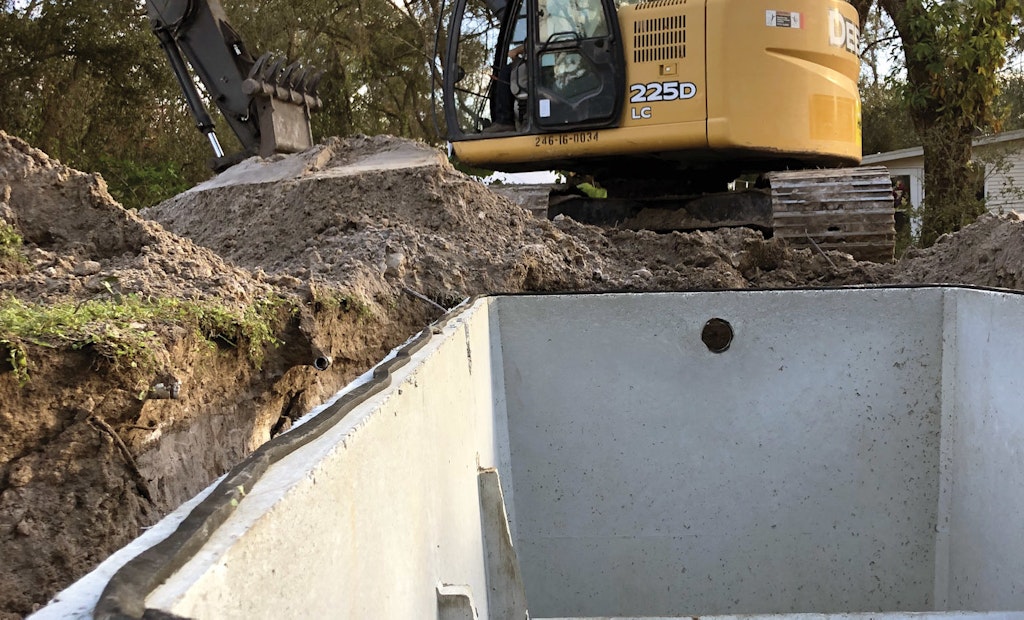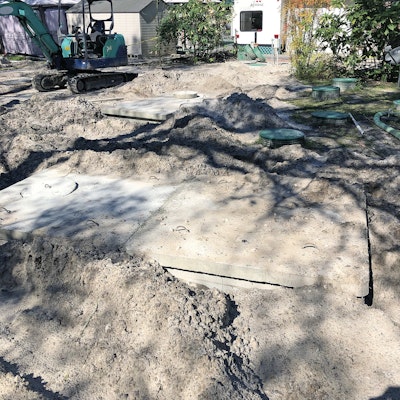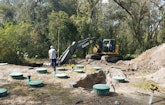
A new tank is ready for its lid at the Sawmill RV Park. The big John Deere was brought to the job for clearing trees. To create enough space for a new drainfield, a number of large oaks had to be removed.
The Sawmill RV Park is a fixture in Dade City, Florida, and it has been expanded numerous times. As a result, it has several wastewater systems serving its cabins and campsites. The problem that brought in Atomic Septic was the failure of an aerobic treatment unit.
The ATUs were installed in 2014, says Ken Williams, who owns Atomic Septic, and failure came quickly. To solve the problem, Williams and his crew installed a new system, replacing the ATUs with a conventional system of tanks and a drainfield designed by Carl Irwin of Advantage Engineering.
Tank and drainfield
An 8-inch Schedule 40 pipe brings wastewater to the beginning of each new system. There are two: one called coconut and the other called cherry.
For coconut, Atomic Septic technicians converted a 3,200-gallon tank from the ATU system into a surge and settling tank. A Liberty pump moves water from this tank about 8 feet into a pair of new 3,000-gallon concrete tanks for septic treatment. Like all the concrete tanks installed, those came from Florida Septic in Eustis.
Wastewater flows a few feet into two preexisting 2,000-gallon tanks that dose the drainfield. These were the original dosing tanks from the ATU system. Each dosing tank is equipped with a pair of 1.5 hp Liberty pumps, and each pump feeds one of four zones in the drainfield. Pumps moved water through about 380 feet of 2-inch force main that dropped to 1.5-inch laterals.
The coconut drainfield is 36 lines of Infiltrator Water Technologies chambers, and each line is 80 feet long.
For the cherry system, the first tank is a 2,000-gallon settling and trash tank. A 1 hp Liberty grinder pump sends wastewater into a pair of 1,000-gallon tanks connected in series. Last is a 2,000-gallon dosing tank also equipped with Liberty pumps that need to move water only about 10 feet to the drainfield.
For the cherry system, the drainfield is eight lines of chambers from Infiltrator, each 84 feet long.
Technicians excavated the loamy clay from drainfield trenches and put in about 24 inches of clean sand under the Infiltrator chambers. About 10 inches of cover went on top, producing a mounded system. Workers brought in 110 loads of fill dirt.
Lids and riser came from Polylok. A pair of Septic Products Inc. duplex panels run the system.
To do the job, the Atomic Septic crew used a:
- John Deere 225D excavator
- IHI 35N mini-excavator
- Bobcat E32 mini-excavator
- Kubota 90 skid-steer
- John Deere 3032E tractor for moving stuff and people around the job site because the two locations were about a quarter-mile apart.
“We pretty much had every piece of equipment in our company out on the job,” Williams says.
Bad install
Atomic Septic’s crew pulled out all the old ATUs — seven units in all. Removal of the drip tubing for those ATUs was part of the operation to install a new drainfield for the septic systems.
Because Atomic Septic wasn’t involved with the ATU system, it’s hard to tell exactly what went wrong, Williams says. It looked as if the soil wasn’t excavated properly before the drip tubing was installed, and the size of the drainfield was reduced by 25% from what would be normal. Yet the park sometimes has an influx of visitors on weekends, and the wastewater flow can reach 10,000 gpd.
The ATUs couldn’t handle that load because there wasn’t enough settling time in the treatment train. A week after the system’s filters were cleaned, it looked as if no cleaning had ever been done, he says. “Once that stuff gets into drip tubing, you’re done for.”
The previous system was installed in 2014.
“Pretty quickly they started experiencing problems, which they passed off as groundwater maybe or just things that weren’t going to happen all the time. About 2016 was when they realized this system was in failure. It actually started blowing out of the ground.”
Working around events
To enlarge the area for the drainfield, the crew had to take out some large oak trees, which is why they brought out a big John Deere 250. But the real challenge on the job was working around the park operations.
It’s a very popular place, Williams says, and it is not unusual for a weekend event to draw 10 times the number of people using the park on weekdays.
They started the project on Jan. 17. “They wanted us to finish within 60 days, and we finished it up within 45,” Williams says.
“The first system was right in the middle of the park and right next to the pool. So to avoid the crowds and cars and parking and traffic — and everybody was interested in what we were doing — we tried to get it done before they had their main event,” he says.
This was also the time in Florida when people come from other parts of the country to escape winter, and the weather in Florida during the installation period was beautiful, Williams says. Even without a special event, some weekends the park was so busy that the crew wasn’t allowed in to work. But wastewater still accumulated quickly.
“We also had a truck on site, and we would have to pump those tanks almost daily,” Williams says.
Some campers stay two to three months at a time, and there are two RV sanitation stations to handle the demand when visitors pull out on a Monday morning.
“That’s one of the reasons we wanted to do the time dose: to help with those flows because on one day, in a couple of hours, you’ve got 50 RVs that empty their tanks that hold 50 or 100 gallons each,” he says.
Drainfields were marked off with rope connected to 4-inch posts. Williams would have preferred a sturdier barrier to deter people from pitching tents on the drainfields, but the owners preferred the aesthetics of the rope and posts.
The work is done, and because Atomic Septic also maintains other equipment in the park, Williams is able to monitor the performance of the replacement system. So far, he says, there hasn’t been a problem.









